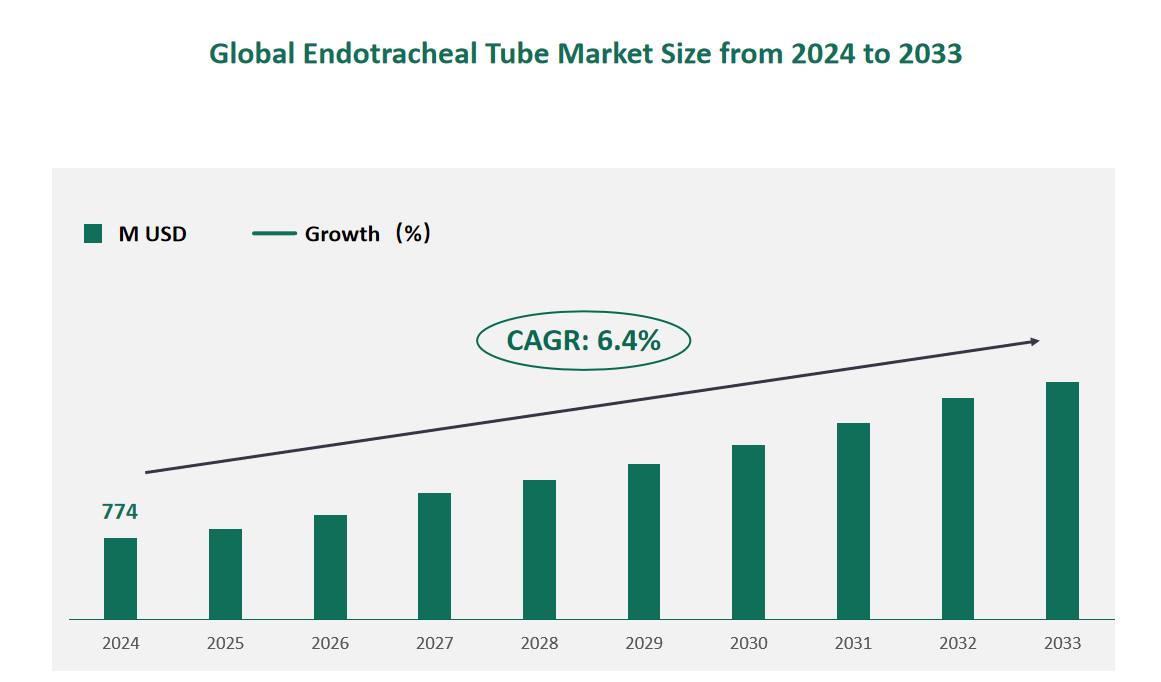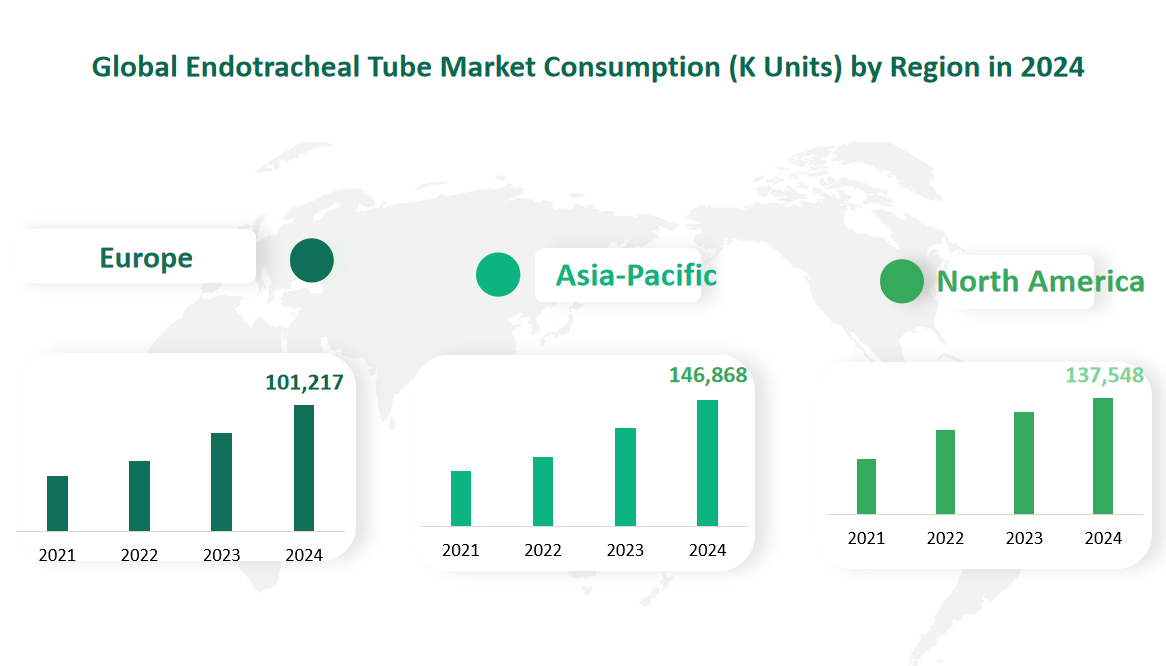1 Global Endotracheal Tube Market Size (Value) and CAGR (2024-2033)
In 2024, the global Endotracheal Tube market was valued at USD 774 million, with a CAGR of 6.4% from 2024 to 2033.
The Endotracheal Tube is a medical catheter that is inserted through the mouth into the windpipe to help the patient breathe.
Figure Global Endotracheal Tube Market Size (M USD) and CAGR 2024-2033

2 Endotracheal Tube Market Drivers
The endotracheal tube market has been experiencing significant growth in recent years, driven by several key factors. One of the primary drivers is the increasing global aging population. As the number of elderly individuals rises, so does the prevalence of chronic diseases such as cardiovascular conditions, cancer, and respiratory illnesses. This demographic shift has led to a higher demand for medical interventions, including the use of endotracheal tubes in critical care settings.
Another significant driver is the improvement in healthcare infrastructure and the expansion of medical insurance coverage. In countries like China, universal medical insurance coverage has been achieved, enabling more people to access necessary medical treatments. Similarly, in developed countries, the increasing ability to pay for medical services has led to a higher demand for advanced medical devices, including endotracheal tubes. Technological advancements have also played a crucial role in the market’s growth. Innovations such as endotracheal tubes with subglottic drainage channels have reduced the risk of ventilator-associated pneumonia (VAP), making these devices more effective and safer for patients.
3 Endotracheal Tube Market Restraints
The endotracheal tube market, despite its growth potential, faces several challenges and restraints that can hinder its expansion and development. One of the most significant challenges is the intense competition among market players. The market is dominated by a few major players, and new entrants often struggle to gain a foothold. This competitive environment can lead to aggressive pricing strategies, which may reduce profit margins for manufacturers.
Another key restraint is the volatility in raw material prices. Endotracheal tubes are primarily made from materials like natural latex, the prices of which are influenced by global supply and demand dynamics, as well as climate conditions. These price fluctuations can make it difficult for manufacturers to maintain stable production costs and pricing strategies.
4 Global Endotracheal Tube Market Consumption (K Units) by Type in 2024
ETTs with subglottic drainage channels are designed to reduce the risk of ventilator-associated pneumonia (VAP) by allowing for the suctioning of secretions that accumulate above the cuff. This feature is particularly beneficial in long-term intubation scenarios, where the risk of infection is higher. According to the latest market research, the consumption of ETTs with subglottic drainage channels in 2024 is projected to reach 149,578 thousand units. This represents a significant portion of the total market, driven by the increasing awareness of the benefits of these tubes in reducing complications associated with intubation.
ETTs without subglottic drainage channels are the more traditional type and are generally less expensive. These tubes are widely used in various medical settings due to their lower cost and sufficient functionality for short-term intubation. In 2024, the consumption of ETTs without subglottic drainage channels is expected to be 245,185 thousand units. This type continues to dominate the market due to its affordability and widespread availability.
Table Global Endotracheal Tube Market Consumption (K Units) by Type in 2024
Type | Market Consumption (K Units) 2024 |
ETT with subglottic drainage channel | 149578 |
ETT without subglottic drainage channel | 245185 |
5 Global Endotracheal Tube Market Consumption (K Units) by Application in 2024
Hospitals are the primary end-users of endotracheal tubes, especially in critical care units and operating rooms. In 2024, the consumption of ETTs in hospitals is projected to reach 178,678 thousand units. This significant consumption is driven by the high volume of surgeries and emergency cases that require intubation. Hospitals often prefer advanced ETTs with subglottic drainage channels to reduce the risk of ventilator-associated pneumonia (VAP) in long-term intubation cases.
Clinics, including outpatient facilities, also utilize endotracheal tubes for various procedures. In 2024, the consumption of ETTs in clinics is expected to be 138,762 thousand units. While clinics typically handle less complex cases compared to hospitals, the increasing number of minor surgeries and emergency interventions in these settings drives the demand for ETTs. The preference in clinics leans towards cost-effective ETTs without subglottic drainage channels due to lower procedural complexity and shorter intubation durations.
Ambulatory surgical centers (ASCs) are specialized facilities that perform surgeries on an outpatient basis. The consumption of ETTs in ASCs in 2024 is projected to be 57,995 thousand units. These centers focus on efficiency and cost-effectiveness, often opting for standard ETTs without subglottic drainage channels. However, the growing trend of performing more complex surgeries in ASCs may lead to increased adoption of advanced ETTs in the future.
Table Global Endotracheal Tube Market Consumption (K Units) by Application in 2024
Application | Market Consumption (K Units) 2024 |
Hospitals | 178678 |
Clinics | 138762 |
Ambulatory Surgical Centers | 57995 |
Others | 19327 |
6 Global Endotracheal Tube Market Consumption (K Units) by Region in 2024
North America, comprising the United States, Canada, and Mexico, is a significant market for endotracheal tubes. In 2024, the region is projected to consume 137,548 thousand units of ETTs. The United States alone is expected to account for 113,713 thousand units, driven by advanced healthcare infrastructure and high demand for medical devices. Canada and Mexico will contribute 16,679 thousand units and 7,156 thousand units, respectively. North America is characterized by stringent regulatory standards and a high adoption rate of advanced medical technologies.
Europe is another major market for endotracheal tubes, with a projected consumption of 101,217 thousand units in 2024. Germany, the UK, and France are the leading countries in this region, with Germany expected to consume 19,987 thousand units. The European market is influenced by robust healthcare systems and a focus on patient safety and quality of care. The adoption of advanced ETTs with subglottic drainage channels is growing, driven by the need to reduce healthcare-associated infections.
The Asia-Pacific region is the fastest-growing market for endotracheal tubes, with a projected consumption of 146,868 thousand units in 2024. China is the dominant player in this region, expected to consume 87,714 thousand units. Japan and South Korea will contribute 14,972 thousand units and 10,413 thousand units, respectively. The Asia-Pacific market is characterized by rapid economic growth, increasing healthcare spending, and improving medical infrastructure. The region is also witnessing a growing demand for advanced medical devices, driven by rising awareness and government initiatives.
Figure Global Endotracheal Tube Market Consumption (K Units) by Region in 2024

7 Major Players in Global Endotracheal Tube Market
7.1 Medtronic
Company Profile: Medtronic, Inc. is a global leader in medical technology, offering a wide range of medical devices and solutions. Established in 1949, Medtronic is headquartered in the United States and operates worldwide. The company is renowned for its innovative and reliable products, which are used in various medical procedures and treatments.
Business Overview: Medtronic specializes in the development and production of medical devices, including surgical instruments, respiratory monitoring systems, and medical supplies. Their products are designed to improve patient outcomes and enhance the efficiency of healthcare delivery. Medtronic’s extensive product portfolio caters to diverse medical needs, making it a key player in the global healthcare industry.
Product and Service Introduction: Medtronic offers a variety of endotracheal tubes, including the Shiley™ Cuffed Basic Endotracheal Tube. This tube is latex-free and available in infant, pediatric, and adult sizes. It features radiopaque markers for accurate placement and is designed to ensure a high level of quality assurance and reliability. The Shiley™ tube is also sterile, making it suitable for use in various medical settings.
Recent Financial Performance: In the most recent fiscal year, Medtronic reported sales of 52,096 thousand units of endotracheal tubes, generating a revenue of 155.14 million USD.
7.2 Teleflex
Company Profile: Teleflex Incorporated is a leading global provider of medical technology products. Founded in 1943, Teleflex is headquartered in the United States and serves customers worldwide. The company is committed to developing and manufacturing high-quality medical devices that meet the needs of healthcare providers and patients.
Business Overview: Teleflex primarily focuses on single-use medical devices used in critical care and surgical applications. Their products are designed to ensure patient safety and improve clinical outcomes. Teleflex’s commitment to innovation and quality has positioned it as a trusted name in the medical device industry.
Product and Service Introduction: Teleflex offers Subglottic Suctioning Endotracheal Tubes, which feature integrated inflation and suction lines. These tubes are designed with a polyurethane cuff and are radiopaque for easy identification. They are also sterile and intended for single use, ensuring optimal hygiene and safety.
Recent Financial Performance: In the most recent fiscal year, Teleflex sold 24,552 thousand units of endotracheal tubes, achieving a revenue of 72.59 million USD.
7.3 Avanos Medical
Company Profile: Avanos Medical, Inc. is a medical technology company that focuses on delivering clinical solutions aimed at reducing the use of opioids and improving patient recovery. Established in 2014, Avanos is headquartered in the United States and operates globally. The company’s products are designed to enhance patient care and outcomes in various medical settings.
Business Overview: Avanos Medical comprises two main franchises: Pain Management and Chronic Care. These franchises address the need for effective pain management and long-term care solutions. Avanos is dedicated to innovation and the development of medical devices that improve patient safety and reduce the risk of complications.
Product and Service Introduction: Avanos Medical offers the MICROCOUFF® Subglottic Suctioning Endotracheal Tube, which features a unique design that allows for effective suctioning of secretions. This tube is designed to reduce the risk of ventilator-associated pneumonia (VAP) by enabling the safe use of saline rinsing and efficient clearing of clogs. The product is sterile and intended for single use.
Recent Financial Performance: In the most recent fiscal year, Avanos Medical sold 14,760 thousand units of endotracheal tubes, generating a revenue of 49.13 million USD.

